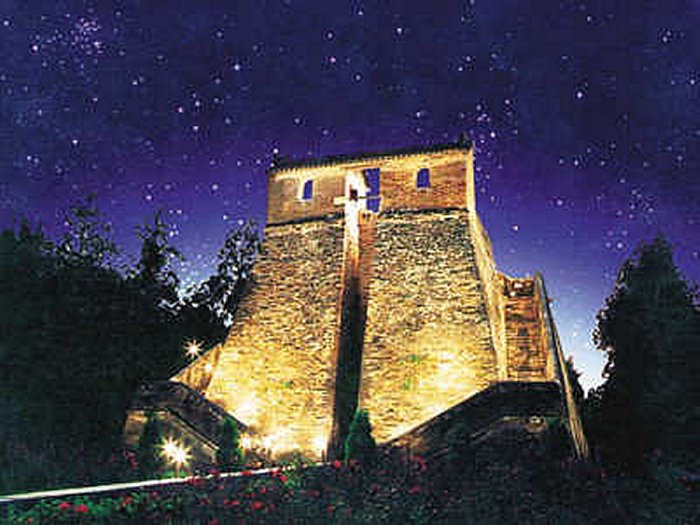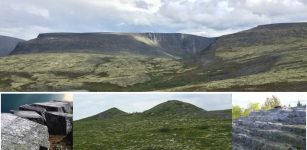Gaocheng: China’s Oldest Observatory And Large Gnomon Installation Of The Ancients
A. Sutherland - AncientPages.com - Astronomical tradition of ancient China was an important part the country’ cultural tradition and dates back to the Bronze Age and 1800 BC. Through the millennia, it changed, but the core – the basic pattern of the Chinese astronomy – remained the same.
To early astronomical observations – especially the passage of the sun - the Chinese used a simple but very powerful instrument known as ‘gnomon’.
The Chinese used a ‘gnomon’ instrument as it was confirmed by archaeologists who discovered the early graphic symbol that represents an idea or perhaps a concept of this useful instrument on Bronze Age oracle bones of Shang Dynasty.
Several accounts of Chinese gnomons – before and after the birth of Jesus Christ – also confirm their use. For example, one such large ‘gnomon installation’ existed at Yang-Cheng town, (now Gao-cheng (Gaocheng), located about 50 miles south east of Louyang, (then, the capital of the Eastern Han Dynasty (25-220 AD).
See also:
Gnomon: Ancient Time Measuring Instrument Used By Babylonians, Egyptians And Chinese
Ancient Genius Jang Yeong-sil And His Brilliant Astronomical Instruments
Probably The Oldest Star Map Discovered In Stone Chamber Of The Kitora Tomb, Asuka Nara, Japan
Elusive Planet Mercury As Seen Through The Eyes Of Ancient Astronomers
Namoratunga: ‘People Of Stone’ And Ancient Astronomical Observatory
The Gaocheng Observatory situated at Dengfeng in the central Chinese province of Henan, is a historic solar observatory with a long tradition: it also has a very powerful structure.

The structure has trapezoidal shape and was constructed of bricks and stones; it is composed of two main parts the body and shigui (‘the ruler to measure the sky’).
It is the oldest astronomical platform in China with tradition that goes back to the time of the Mongol rule. It was built from 1267 to 1269 during the Yuan Dynasty (1271-1368), when the Empire of Yuan was established and it was used for observations of the stars, the sun and for recording of time.
The structure is also one of the most ancient observatories in the world.
Additionally, there have been commissioned the construction of 27 observatories the so-called 'observation stations' scattered across the China.
The Gaocheng Observatory played an important role because it was determined to be the 'earth core', which means the most central point on the surface on our planet. It delivered very precise observations.

Astronomical tradition of ancient China was an important part the country’ cultural tradition and dates back to the Bronze Age and 1800 BC
The structure has trapezoidal shape and was constructed of bricks and stones; it is composed of two main parts the body and shigui (‘the ruler to measure the sky’).
It is 9.46 meters high by itself, and 12.62 meters high if the 2 cabinets on the top are included. The somewhat unconventional gnomon is a bar mounted horizontally between the 2 cabinets. The shigui extending to the far north is 31.9-m-long stone measurement path that stretches out in front of the building and is used to measure the sun's shadow.
It is made up of 36 square stones with two parallel waterways on it to check its levelness. The location of shigui is in accordance with the direction we take today to measure the Meridian. External stairway lead to the structure’s top.
Gaocheng Observatory was designed by Guo Shoujing (1231-1314) who was an inventor, mathematician and astronomer. He used his engineering skills to advance several instruments indispensable for measuring of celestial bodies.
Written by – A. Sutherland - AncientPages.com Senior Staff Writer
Copyright © AncientPages.com All rights reserved. This material may not be published, broadcast, rewritten or redistributed in whole or part without the express written permission of AncientPages.com
Expand for referencesReferences:
F. Wang, Geo-Architecture and Landscape in China’s Geographic and Historic Context
More From Ancient Pages
-
 Dance Was A Gift Of The Gods To Ancient Greeks
Featured Stories | Oct 4, 2021
Dance Was A Gift Of The Gods To Ancient Greeks
Featured Stories | Oct 4, 2021 -
 Unusual Scenes Painted On The Walls Inside Egyptian Tomb Of General Iwrkhy – Discovered
Archaeology | May 10, 2018
Unusual Scenes Painted On The Walls Inside Egyptian Tomb Of General Iwrkhy – Discovered
Archaeology | May 10, 2018 -
 Excavations Revealed Evidence That Early Humans Lived In Britain More Than 700,000 Years Ago
Archaeology | Sep 15, 2025
Excavations Revealed Evidence That Early Humans Lived In Britain More Than 700,000 Years Ago
Archaeology | Sep 15, 2025 -
 Long Mysterious Tunnel Discovered Inside The Khufu Pyramid
Archaeology | Mar 2, 2023
Long Mysterious Tunnel Discovered Inside The Khufu Pyramid
Archaeology | Mar 2, 2023 -
 Enigmatic Shaman Who Saved Canadian City And Island From British Enemy Ships And Then Mysteriously Vanished
Featured Stories | Oct 20, 2025
Enigmatic Shaman Who Saved Canadian City And Island From British Enemy Ships And Then Mysteriously Vanished
Featured Stories | Oct 20, 2025 -
 Independent Innovations In Stone Tool Manufacturing Across Europe And The Middle East
Archaeology | Oct 16, 2025
Independent Innovations In Stone Tool Manufacturing Across Europe And The Middle East
Archaeology | Oct 16, 2025 -
 Mysterious Kola Pyramids Built By An Unknown Lost Ancient Civilization Can Rewrite Ancient History
Civilizations | Aug 3, 2020
Mysterious Kola Pyramids Built By An Unknown Lost Ancient Civilization Can Rewrite Ancient History
Civilizations | Aug 3, 2020 -
 Ancient Knowledge Of Levitation And Antigravity
Ancient Mysteries | Jan 24, 2016
Ancient Knowledge Of Levitation And Antigravity
Ancient Mysteries | Jan 24, 2016 -
 One Of The Biggest Bronze Age Settlements On Orkney – Discovered
Archaeology | Dec 11, 2015
One Of The Biggest Bronze Age Settlements On Orkney – Discovered
Archaeology | Dec 11, 2015 -
 The Egyptian Dream Book Reveals Ancient Predictions Of The Future
Egyptian Mythology | Jun 6, 2020
The Egyptian Dream Book Reveals Ancient Predictions Of The Future
Egyptian Mythology | Jun 6, 2020 -
 Earliest And Largest Scythian Princely Tomb Discovered In Siberia By Swiss Archaeologist
Archaeology | Jan 16, 2018
Earliest And Largest Scythian Princely Tomb Discovered In Siberia By Swiss Archaeologist
Archaeology | Jan 16, 2018 -
 Why Did We Abandon Roman Numerals?
Ancient History Facts | Apr 25, 2019
Why Did We Abandon Roman Numerals?
Ancient History Facts | Apr 25, 2019 -
 Curious Ancient Copper Plates And The Mystery Of Indus Valley
Artifacts | Oct 24, 2015
Curious Ancient Copper Plates And The Mystery Of Indus Valley
Artifacts | Oct 24, 2015 -
 Mysterious Location Of The Amazing Land Of Punt – Can This Puzzle Be Solved One Day?
Featured Stories | Jul 18, 2016
Mysterious Location Of The Amazing Land Of Punt – Can This Puzzle Be Solved One Day?
Featured Stories | Jul 18, 2016 -
 What Was The Danelaw?
Ancient History Facts | Jun 4, 2016
What Was The Danelaw?
Ancient History Facts | Jun 4, 2016 -
 Hidden Manuscripts Reveal Ancient Sacred Wisdom Of The Gods And Surprises
Ancient Mysteries | Mar 23, 2019
Hidden Manuscripts Reveal Ancient Sacred Wisdom Of The Gods And Surprises
Ancient Mysteries | Mar 23, 2019 -
 Ceiba Tree: Sacred Tree Of Life Of Maya People And Universal Concept In Ancient Beliefs
Celtic Mythology | Jun 12, 2017
Ceiba Tree: Sacred Tree Of Life Of Maya People And Universal Concept In Ancient Beliefs
Celtic Mythology | Jun 12, 2017 -
 New Pyramid Discovered In The Sacred City Of Caral – Home To South America’s Oldest Civilization
Archaeology | Feb 10, 2025
New Pyramid Discovered In The Sacred City Of Caral – Home To South America’s Oldest Civilization
Archaeology | Feb 10, 2025 -
 Graeco-Roman Era Rock-Cut Tomb Unearthed In Aswan West Bank, Upper Egypt
Archaeology | Apr 24, 2019
Graeco-Roman Era Rock-Cut Tomb Unearthed In Aswan West Bank, Upper Egypt
Archaeology | Apr 24, 2019 -
 Cooking, Roasting And Eating Of Root Plants Is 120,000-Year-Old Habit
Archaeology | Jun 7, 2019
Cooking, Roasting And Eating Of Root Plants Is 120,000-Year-Old Habit
Archaeology | Jun 7, 2019

